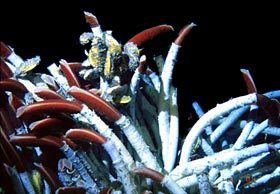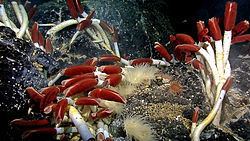Kingdom Animalia Genus Riftia Phylum Annelida Higher classification Riftia | Family Siboglinidae Scientific name Riftia pachyptila Rank Species Order Canalipalpata | |
 | ||
Similar Siboglinidae, Annelid, Polychaete, Lamellibrachia, Serpulidae | ||
Giant tube worms of the galapagos nautilus live
Giant tube worms, Riftia pachyptila, are marine invertebrates in the phylum Annelida (formerly grouped in phylum Pogonophora and Vestimentifera) related to tube worms commonly found in the intertidal and pelagic zones. Riftia pachyptila live over a mile deep, and up to several miles deep, on the floor of the Pacific Ocean near black smokers, and can tolerate extremely high hydrogen sulfide levels. These worms can reach a length of 2.4 m (7 ft 10 in) and their tubular bodies have a diameter of 4 cm (1.6 in). Ambient temperature in their natural environment ranges from 2 to 30 degrees Celsius.
Contents
- Giant tube worms of the galapagos nautilus live
- Facts giant tube worms riftia pachyptila
- Development
- Body structure
- Energy and nutrient source
- Reproduction
- Growth rate and age
- References

The common name "giant tube worm" is however also applied to the largest living species of shipworm, Kuphus polythalamia, which despite the name "worm" is a bivalve mollusc, rather than an annelid.

Facts giant tube worms riftia pachyptila
Development

Riftia develop from a free-swimming, pelagic, non-symbiotic trochophore larva, which enters juvenile (metatrochophore) development, becoming sessile and subsequently acquiring symbiotic bacteria. The symbiotic bacteria, on which adult worms depend for sustenance, are not present in the gametes, but are acquired from the environment via the digestive tract. The digestive tract transiently connects from a mouth at the tip of the ventral medial process to a foregut, midgut, hindgut and anus. After symbionts are established in the midgut, it undergoes substantial remodelling and enlargement to become the trophosome, while the remainder of the digestive tract has not been detected in adult specimens.
Body structure
They have a highly vascularized, red "plume" at the tip of their free end which is an organ for exchanging compounds with the environment (e.g., H2S, CO2, O2, etc.). The tube worm does not have many predators. If threatened, the plume may be retracted into the worm's protective tube. The plume provides essential nutrients to bacteria living inside the trophosome. Tube worms have no digestive tract, but the bacteria (which may make up half of a worm's body weight) convert oxygen, hydrogen sulfide, carbon dioxide, etc. into organic molecules on which their host worms feed. This process, known as chemosynthesis, was recognized within the trophosome by Colleen Cavanaugh.
The bright red color of the plume structures results from several extraordinarily complex hemoglobins, which contain up to 144 globin chains (each presumably including associated heme structures). These tube worm hemoglobins are remarkable for carrying oxygen in the presence of sulfide, without being inhibited by this molecule as hemoglobins in most other species are.
Nitrate and nitrite are toxic, but nitrogen is required for biosynthetic processes. The chemosynthetic bacteria within the trophosome convert this nitrate to ammonium ions, which then are available for production of amino acids in the bacteria, which are in turn released to the tube worm. To transport nitrate to the bacteria, R. pachyptila concentrate nitrate in their blood, to a concentration 100 times more concentrated than the surrounding water. The exact mechanism of R. pachyptila’s ability to withstand and concentrate nitrate is still unknown.
Energy and nutrient source
With sunlight not available directly as a form of energy, the tube worms rely on bacteria in their habitat to oxidize hydrogen sulfide, using dissolved oxygen in the water as an electron acceptor. This reaction provides the energy needed for chemosynthesis. For this reason, tube worms are partially dependent on sunlight as an energy source, since they use free oxygen, which has been liberated by photosynthesis in water layers far above, to obtain nutrients. In this way tube worms are similar to many forms of life which live in the ocean below depths that sunlight can penetrate. However, tube worms are unique in being able to use bacteria to indirectly obtain almost all the materials they need for growth from molecules dissolved in water. Some nutrients have to be filtered out of the water. Tube worm growth resembles that of hydroponically grown fungi more than it does that of typical animals which need to "eat".
Reproduction
To reproduce, Riftia pachyptila females release lipid-rich eggs into the surrounding water so they start to float upwards. The males then unleash sperm bundles that swim to meet the eggs. After the eggs have hatched, the larvae swim down to attach themselves to the rock.
Growth rate and age
Riftia pachyptila has the fastest growth rate of any known marine invertebrate. These organisms have been known to colonize a new site, grow to sexual maturity and increase in length to 4.9 feet (1.5 m) in less than two years. This is in sharp contrast to Lamellibrachia luymesi, the tube worms that live at deep sea cold seeps and grow very slowly for most of their lives. It takes from 170 to 250 years for Lamellibrachia luymesi to grow 2 meters in length, and even longer worms have been discovered.
